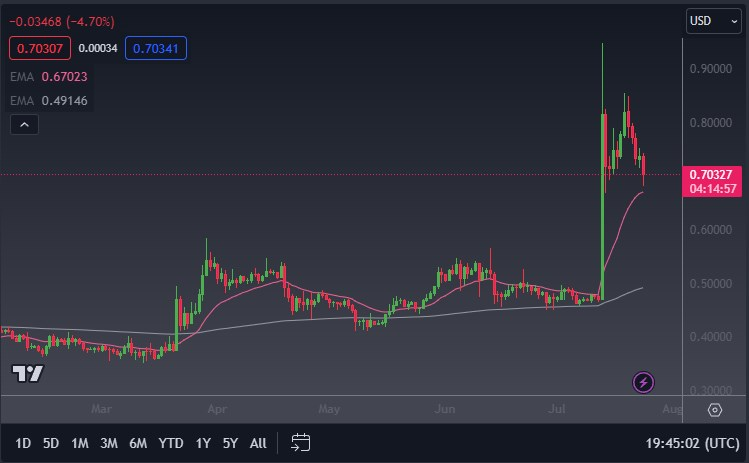In the fast-paced world of financial trading, understanding the various market phenomena can make all the difference between success and failure. One such critical concept that traders must be aware of is the “bull trap.” A bull trap is a deceptive market situation that can lead to significant losses if not recognized and avoided in time. By delving into the intricacies of how bull traps occur and learning how to sidestep them, traders can enhance their decision-making abilities and safeguard their investments.
Understanding the Concept of a Bull Trap

A bull trap, in the context of trading, occurs when there is a false signal indicating the start of a bullish trend. It tricks investors into believing that an asset’s value is about to rise, prompting them to buy at seemingly opportune moments. However, the upward movement is short-lived, and the asset’s price soon reverses, resulting in sudden losses for those who fell for the trap.
It is essential to contrast the bull trap briefly with its counterpart, the bear trap. A bear trap operates similarly but with price movement in the opposite direction. It presents a deceptive signal suggesting a bearish trend, prompting traders to sell their assets, only for the price to rebound, causing losses to short sellers.
Identifying a Bull Trap: Key Indicators
Recognizing a bull trap is crucial for traders to protect their capital. Several key indicators and warning signs can help identify this market phenomenon. One prominent indicator is a sudden and sharp price increase after a prolonged downtrend. This can trick traders into believing that the asset’s value is rebounding when, in reality, it’s just a temporary spike upward price movement.
Another signal of a bull trap is unusually high or low trading volume accompanying the price surge. Many traders jumping on the perceived bullish trend lead to increased activity in the market, but this surge may not be sustainable. It comes down to sustainability, and whether the trend has truly set in.
Technical analysis tools such as moving averages, MACD (Moving Average Convergence Divergence), and RSI (Relative Strength Index) can also aid in spotting potential bull traps. That being said, charting isn’t the total solution, it is important to understand the fundamentals of the asset that you are trading. Remember, a blending strategy is the best way to approach most markets.
The Impact of Falling into a Bull Trap
Falling into a bull trap can have significant financial and psychological effects on traders. Financially, traders may suffer substantial losses due to buying assets at inflated prices during the trap. This can erode their capital and hinder their ability to trade or to participate in genuine profitable opportunities.
Psychologically, falling for a bull trap can dent a trader’s confidence and decision-making abilities. It may lead to fear, hesitation, or even impulsiveness in future trades, hindering their overall performance. The markets are littered with the bodies of those who had short positions that they seemingly are “stuck in” as they wait, sometimes prey, for a reversal in trend again.
For example, there are people that are still waiting for Bitcoin to return to $60,000. Will it go back to that level? Maybe, but they had to endure massive losses of well over 60 percent along the way. This is no way to invest or trade.
It is much better to take a loss along the way, mainly because this allows more practical ways to improve your portfolio. When the market you were in drops, there will be other opportunities out there that you can take advantage of. Or, if you are trading at PrimeXBT, you can easily reverse your positions, as they are CFD markets, and offer ease of shorting positions, with a simply click of the button. This is one of the many great reasons to trade with us.
This is especially important in the crypto markets, as you don’t have to borrow crypto in order to “go short.” You are simply trading with the idea of gaining from declining price action, without the hassle of custody. In order to do this in the traditional markets, you need to borrow an asset, or go into the futures markets, which is extremely expensive. Or, in this case, you could simply “go long” another asset that is rising. While crypto got hammered, the indices did quite well. This is the advantage of being able to trade the global markets on the whole. Diversity.
Common Mistakes to Avoid When Identifying Bull Traps
Several common mistakes often lead traders into bull traps. By being aware of these pitfalls, traders can actively avoid them. Some of the most prevalent mistakes include:
- Over reliance on Short-term Signals: Relying solely on short-term indicators may not provide a comprehensive view of the market, making traders susceptible to false signals. This can be contered by not only paying attention to your particular time frame, but also the longer-term time frames such as the weekly to see if the market participants are learning too far in one direction.
- Ignoring the Bigger Picture: Failing to consider the broader market trends and macroeconomic factors can lead to misinterpretation of price movements. Remember that bear markets end eventually, and this is something to watch out for.
- Ignoring Risk Management: Neglecting risk management practices can exacerbate losses when falling into a bull trap. It is important to set stop loss orders above resistance levels in order to identify when things might be changing.
- Chasing the Trend: Jumping on a perceived bullish trend without conducting thorough research can be disastrous. This is also true when trying to jump in bear markets when they have been running for some time.
Strategies to Avoid Falling into a Bull Trap
To steer clear of bull traps in bear markets, traders can implement the following strategies:
- Long-term Analysis: Focus on long-term trends and analyze multiple time frames to gain a comprehensive understanding of the asset’s behavior. If you notice a sudden upward price movement in a market that has been struggling, you may be getting ready to see a bull trap.
- Confirmation from Multiple Indicators: Wait for confirmation from multiple technical indicators before making trading decisions.
- Risk Management: Set stop-loss orders to limit potential losses and adhere to position sizing principles. Obviously, you want to avoid bull traps, but at the end of the day, the reality is that you won’t always be successful, and this is where the stop loss orders comes into the picture.
- Fundamental Analysis: Combine technical analysis with fundamental analysis to validate potential trends. While much more difficult to measure, it is the reason that people will want to buy or sell an asset.
- Learning from Experts: Seek advice from experienced traders or financial advisors to gain valuable insights. After all, if they have been there before, it makes sense that you utilize the benefit of their experience.
Case Studies of Bull Traps
Let’s explore some real-world examples of bull traps:
Case Study 1: The Tech Bubble of the Early 2000s
During the late 1990s and early 2000s, the tech sector experienced a massive bubble, with stocks of internet companies skyrocketing. Many investors jumped on the bandwagon, believing that the technology industry was entering a new era of unprecedented growth. However, the bubble eventually burst, causing a sharp decline in tech stock prices and inflicting substantial losses on unsuspecting investors.
Case Study 2: Cryptocurrency Bull Trap
In the cryptocurrency market, bull traps have been relatively common. For instance example, in early 2018, Bitcoin experienced a significant surge in price, attracting many new investors hoping for further gains. Unfortunately, the price soon plummeted, leaving these investors with heavy losses.
In both cases, the bull traps were driven by exuberance and excessive optimism, leading to unsustainable stock price, increases.

Conclusion: The Importance of Understanding Bull Traps for Successful Trading
In conclusion, a bull trap can be a treacherous pitfall for traders, luring them into making ill-informed decisions and inflicting severe financial and psychological consequences. Understanding this phenomenon and learning to identify and avoid potential bull trap and traps is crucial for any trader looking to thrive in the volatile world of financial markets.
By remaining vigilant, conducting thorough analysis and investment research, and avoiding common mistakes, traders can navigate through potential bull traps and make sound investment choices. Remember, successful trading is not about avoiding losses entirely but about managing risks intelligently and making informed decisions based on a clear understanding of market dynamics.
Remember, the path to profitable trading lies in knowledge, discipline, and the ability to stay calm amidst market uncertainties. Happy trading!
What is meant by bull trap?
A bull trap is a deceptive market situation in trading where a false signal suggests the start of a bullish trend. It tricks investors into using money and buying assets, only for the price to reverse, causing sudden losses.
Is a bull trap bullish or bearish?
A bull trap is initially perceived as bullish, as buyers as it appears to signal a start of an upward trend. However, it eventually leads to bearish price action, catching investors off-guard.
What is bull trap in Crypto?
In the context of cryptocurrencies, a bull trap refers to a situation where there is a false signal suggesting a significant price increase. Many investors buy into the perceived bullish trend, but the stock's price soon drops, resulting in losses.
What causes bull traps?
What is a bull trap? Bull traps are often caused by stock market over exuberance, excessive optimism, and the over reliance on short-term indicators. Additionally, factors like high trading volumes and lack of comprehensive analysis can contribute to bull traps.




